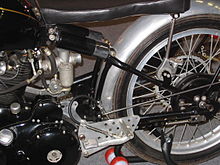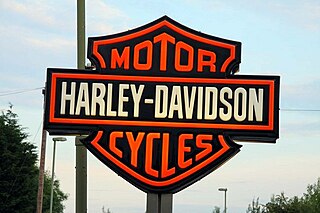
Harley-Davidson, Inc. is an American motorcycle manufacturer headquartered in Milwaukee, Wisconsin, United States. Founded in 1903, it is one of two major American motorcycle manufacturers to survive the Great Depression along with its historical rival, Indian Motorcycles. The company has survived numerous ownership arrangements, subsidiary arrangements, periods of poor economic health and product quality, and intense global competition to become one of the world's largest motorcycle manufacturers and an iconic brand widely known for its loyal following. There are owner clubs and events worldwide, as well as a company-sponsored, brand-focused museum.

The Cannondale Bicycle Corporation is an American division of Dutch conglomerate Pon Holdings that supplies bicycles. Its headquarters are in Wilton, Connecticut, with engineering offices in Freiburg, Germany. Frames are manufactured in Taiwan. Bikes are assembled in Taiwan, as well as in the USA and in The Netherlands for the local markets.

A chopper is a type of custom motorcycle which emerged in the US state of California in the late 1950s. A chopper employs modified steering angles and lengthened forks for a stretched-out appearance. They can be built from an original motorcycle which is modified ("chopped") or built from scratch. Some of the characteristic features of choppers are long front ends with extended forks often coupled with an increased rake angle, hardtail frames, very tall "ape hanger" or very short "drag" handlebars, lengthened or stretched frames, and larger than stock front wheel. To be considered a chopper a motorcycle frame must be cut and welded at some point. I.e. the name chopper. The "sissy bar", a set of tubes that connect the rear fender with the frame, and which are often extended several feet high, is a signature feature on many choppers.
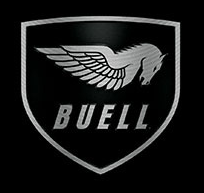
Buell Motorcycles is an American motorcycle manufacturer based in Grand Rapids, Michigan, United States. It was founded in 1983 by ex-Harley-Davidson engineer Erik Buell. Harley-Davidson acquired 49 percent of Buell in 1993, and Buell became a wholly owned subsidiary of Harley-Davidson by 2003. On November 17, 2006, Buell announced that it had produced and shipped its 100,000th motorcycle.

A swingarm, or "swinging arm" (UK), originally known as a swing fork or pivoted fork, is a single or double sided mechanical device which attaches the rear wheel of a motorcycle to its body, allowing it to pivot vertically. The main component of the rear suspension of most modern motorbikes and ATVs, it holds the rear axle firmly, while pivoting to absorb bumps and suspension loads induced by the rider, acceleration, and braking.

The Suzuki GSX-R750 is a sports motorcycle made by Suzuki since 1984. It was introduced at the Cologne Motorcycle Show in October 1984 as a motorcycle of the GSX-R series for the 1985 model year.

The Harley-Davidson Sportster is a line of motorcycles produced continuously since 1957 by Harley-Davidson. Sportster models are designated in Harley-Davidson's product code by beginning with "XL". In 1952, the predecessors to the Sportster, the Model K Sport and Sport Solo motorcycles, were introduced. These models K, KK, KH, and KHK of 1952 to 1956 had a sidevalve engine, whereas the later XL Sportster models use an overhead valve engine. The first Sportster in 1957 had many of the same details of the KH including the frame, fenders, large gas tank and front suspension.
A motorcycle's suspension serves a dual purpose: contributing to the vehicle's handling and braking, and providing safety and comfort by keeping the vehicle's passengers comfortably isolated from road noise, bumps and vibrations.
The Ducati SportClassics are a range of retro styled motorcycles introduced by Ducati at the 2003 Tokyo Motor Show, and put on sale in 2005 for the 2006 model year. The Paul Smart version was made for the 2006 model year only, while the Sport1000 ran from 2006 through the 2009 model years, and the GT1000 ran from the 2007 through 2010 model years.
The Harley-Davidson Twin Cam are motorcycle engines made by Harley-Davidson from 1998 to 2017. Although these engines differed significantly from the Evolution engine, which in turn was derived from the series of single camshaft, overhead valve motors that were first released in 1936, they share a number of characteristics with nearly all previous Harley-Davidson engines. Both engines have two cylinders in a V-twin configuration at 45°, are air-cooled, and activate valves with push-rods. The crankshafts have a single pin with a knife and fork arrangement for the connecting rods. These are sandwiched between a pair of flywheels.

Bicycle suspension is the system, or systems, used to suspend the rider and bicycle in order to insulate them from the roughness of the terrain. Bicycle suspension is used primarily on mountain bikes, but is also common on hybrid bicycles.
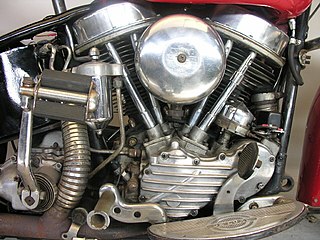
Harley-Davidson FL is a model designation used for Harley-Davidson motorcycles since 1941, when F referred to the new large capacity 74 cui (1200cc) variant of the V-2 Overhead valve engine (″Knucklehead″) that was introduced in 1936 as Model E with 61 cui (1000cc). The presence of an additional letter L indicated higher compression, offering more power but requiring higher octane gasoline. In 1950s, the low compression version was discontinued, and in 1952 also the low capacity EL, making FL the standard engine and model designation for decades to come.
The Harley-Davidson Super Glide was a motorcycle made by the Harley-Davidson. Reputed to be the first factory custom motorcycle, it originated Harley-Davidson's FX series of motorcycles by mating Sportster components, most notably the front end, with the chassis of their larger big twin motorcycles. Super Glide models from 1991 to 2018 were based on the Dyna Glide chassis which has a wider variety of front ends and trim levels, and for a time filled the intermediate niche between the smallest and largest Harley-Davidson models; the Dyna platform has since been discontinued for the 2018 model year in favor of the new Softail frame, with some models from the Dyna nameplate being carried over to the Softail line.

The Kawasaki Ninja ZX-9R is a motorcycle in the Ninja sport bike series from Japanese manufacturer Kawasaki, produced from 1994 until 2003. There were five model incarnations across two basic designs.

A motorcycle frame is a motorcycle's core structure. It supports the engine, provides a location for the steering and rear suspension, and supports the rider and any passenger or luggage. Also attached to the frame are the fuel tank and battery. At the front of the frame is found the steering head tube that holds the pivoting front fork, while at the rear there is a pivot point for the swingarm suspension motion. Some motorcycles include the engine as a load-bearing stressed member; while some other bikes do not use a single frame, but instead have a front and a rear subframe attached to the engine.
Motorcycle components and systems for a motorcycle are engineered, manufactured, and assembled in order to produce motorcycle models with the desired performance, aesthetics, and cost. The key components of modern motorcycles are presented below.

A bobber, originally called a bob-job from the 1930s through 1990s, is a style of custom motorcycle. The typical construction includes removing the front fender, shortening the rear fender, which is "bobbed", and stripping excess bodywork as well as all superfluous parts to reduce weight.

Harley-Davidson CVO for motorcycles are a family of models created by Harley-Davidson for the factory custom market. For every model year since the program's inception in 1999, Harley-Davidson has chosen a small selection of its mass-produced motorcycle models and created limited-edition customizations of those platforms with larger-displacement engines, costlier paint designs, and additional accessories not found on the mainstream models. Special features for the CVO lineup have included performance upgrades from Harley's "Screamin' Eagle" branded parts, hand-painted pinstripes, ostrich leather on seats and trunks, gold leaf incorporated in the paint, and electronic accessories like GPS navigation systems and iPod music players.

The Harley-Davidson Fat Boy, is a V-twin softail cruiser motorcycle with solid-cast disc wheels. Designed by Willie G. Davidson and Louie Netz, Harley-Davidson built a prototype Fat Boy in Milwaukee for the Daytona Bike Week rally at Daytona Beach in 1988 and 1989. Fat Boys produced from 1990-2017 are coded FLSTF, and FLFB from 2018.
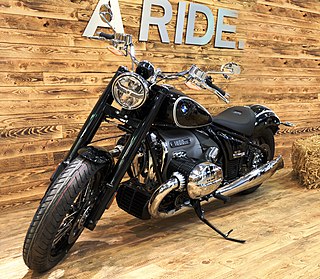
The BMW R 18 is a cruiser motorcycle manufactured by BMW Motorrad and was officially introduced in April 2020 and launched in September 2020 in Germany. Due to the COVID-19 pandemic, an official introduction at the BMW dealers was not possible, therefore it was presented virtually on the internet.



